Dancing at the Other Met
Does dance belong inside a museum? Fine art institutions have recently become the venue of choice for today’s trendiest choreographers (see: Benjamin Millepied, Jonah Bokaer, Anne Teresa De Keersmaeker). Writer Elaine Stuart even wrote a thoughtful piece in our January issue about how this fad is impacting the dance world.
Curious to see a museum dance piece firsthand, last night I went to the Metropolitan Museum of Art to watch Twinned, featuring Dance Heginbotham and a band called Alarm Will Sound. The program included a piece that was previously created for a conventional proscenium stage, as well as a premiere choreographed specifically for the Met’s Charles Engelhard Court.
Unsurprisingly, the atmosphere gave the choreography a certain weight. The Met is a prestigious, reverent place, and you expect to see something deep and profound inside of it. But I hadn’t anticipated how much the movements themselves would matter. I found myself taking every step and gesture very seriously—until I was completely thrown off by booty popping, shimmies and jazz hands. These motions were probably fun in a their original setting, but here they felt silly, even a little awkward.
I also found it took a group of dancers to feel sufficient enough to stand up next to the larger-than-life statues they were dancing around. An opening duet seemed thin, but once the “stage” was flooded with performers, the movement made sense, and finally proportionate to its surroundings.
Throughout the program, I kept wondering whether the dancing would have been more or less effective in a traditional theater. My answer changed depending on what that section of the piece was doing. A group of five dancers imitating jockeys might have gone over better if they hadn’t had to compete with such imposing architecture and stained glass windows. (Oddly, this was the section that was specifically choreographed for the site.) But there was also a moment where the performers were filling the space, with a group slowly circling a central golden statue. The solemn mood was so completely fitting that in that instant, the Met’s grand court completely elevated the choreography, and there was nowhere else I could have imagined it being performed with such breathtaking impact.





